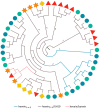Comparative Study of Lectin Domains in Model Species: New Insights into Evolutionary Dynamics
- PMID: 28587095
- PMCID: PMC5485960
- DOI: 10.3390/ijms18061136
Comparative Study of Lectin Domains in Model Species: New Insights into Evolutionary Dynamics
Abstract
Lectins are present throughout the plant kingdom and are reported to be involved in diverse biological processes. In this study, we provide a comparative analysis of the lectin families from model species in a phylogenetic framework. The analysis focuses on the different plant lectin domains identified in five representative core angiosperm genomes (Arabidopsisthaliana, Glycine max, Cucumis sativus, Oryza sativa ssp. japonica and Oryza sativa ssp. indica). The genomes were screened for genes encoding lectin domains using a combination of Basic Local Alignment Search Tool (BLAST), hidden Markov models, and InterProScan analysis. Additionally, phylogenetic relationships were investigated by constructing maximum likelihood phylogenetic trees. The results demonstrate that the majority of the lectin families are present in each of the species under study. Domain organization analysis showed that most identified proteins are multi-domain proteins, owing to the modular rearrangement of protein domains during evolution. Most of these multi-domain proteins are widespread, while others display a lineage-specific distribution. Furthermore, the phylogenetic analyses reveal that some lectin families evolved to be similar to the phylogeny of the plant species, while others share a closer evolutionary history based on the corresponding protein domain architecture. Our results yield insights into the evolutionary relationships and functional divergence of plant lectins.
Keywords: carbohydrate; evolution; lectin; phylogeny; protein domain.
Conflict of interest statement
The authors declare no conflict of interest.
Figures







Similar articles
-
Distribution and evolution of the lectin family in soybean (Glycine max).Molecules. 2015 Feb 11;20(2):2868-91. doi: 10.3390/molecules20022868. Molecules. 2015. PMID: 25679048 Free PMC article.
-
Genome-wide identification and domain organization of lectin domains in cucumber.Plant Physiol Biochem. 2016 Nov;108:165-176. doi: 10.1016/j.plaphy.2016.07.009. Epub 2016 Jul 10. Plant Physiol Biochem. 2016. PMID: 27434144
-
Lectin Sequence Distribution in QTLs from Rice (Oryza sativa) Suggest A Role in Morphological Traits and Stress Responses.Int J Mol Sci. 2019 Jan 20;20(2):437. doi: 10.3390/ijms20020437. Int J Mol Sci. 2019. PMID: 30669545 Free PMC article.
-
F-type Lectin Domains: Provenance, Prevalence, Properties, Peculiarities, and Potential.Adv Exp Med Biol. 2018;1112:345-363. doi: 10.1007/978-981-13-3065-0_24. Adv Exp Med Biol. 2018. PMID: 30637709 Review.
-
Classification of plant lectins in families of structurally and evolutionary related proteins.Adv Exp Med Biol. 2001;491:27-54. doi: 10.1007/978-1-4615-1267-7_3. Adv Exp Med Biol. 2001. PMID: 14533788 Review.
Cited by
-
Gene Expression Patterns for Proteins With Lectin Domains in Flax Stem Tissues Are Related to Deposition of Distinct Cell Wall Types.Front Plant Sci. 2021 Apr 26;12:634594. doi: 10.3389/fpls.2021.634594. eCollection 2021. Front Plant Sci. 2021. PMID: 33995436 Free PMC article.
-
Growing Maize Root: Lectins Involved in Consecutive Stages of Cell Development.Plants (Basel). 2022 Jul 7;11(14):1799. doi: 10.3390/plants11141799. Plants (Basel). 2022. PMID: 35890433 Free PMC article.
-
OsAPSE modulates non-covalent interactions between arabinogalactan protein O-glycans and pectin in rice cell walls.Front Plant Sci. 2025 May 22;16:1588802. doi: 10.3389/fpls.2025.1588802. eCollection 2025. Front Plant Sci. 2025. PMID: 40475901 Free PMC article.
-
Identification of N-linked glycans as specific mediators of neuronal uptake of acetylated α-Synuclein.PLoS Biol. 2019 Jun 18;17(6):e3000318. doi: 10.1371/journal.pbio.3000318. eCollection 2019 Jun. PLoS Biol. 2019. PMID: 31211781 Free PMC article.
-
Research advances and prospects of legume lectins.J Biosci. 2021;46(4):104. doi: 10.1007/s12038-021-00225-8. J Biosci. 2021. PMID: 34815374 Free PMC article. Review.
References
-
- Arabidopsis Genome Initiative Analysis of the genome sequence of the flowering plant Arabidopsis thaliana. Nature. 2000;408:796–815. - PubMed
MeSH terms
Substances
LinkOut - more resources
Full Text Sources
Other Literature Sources
Research Materials

